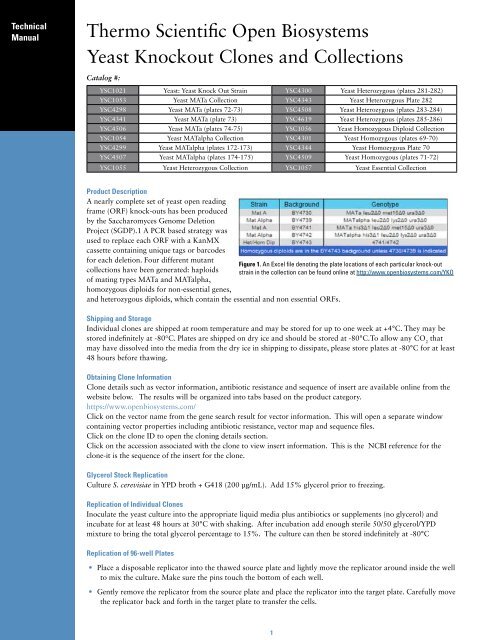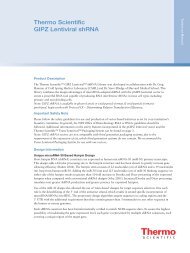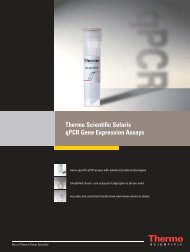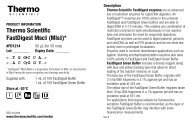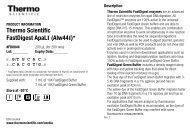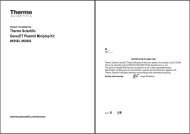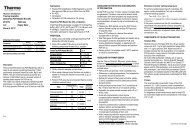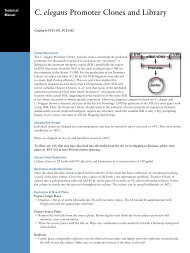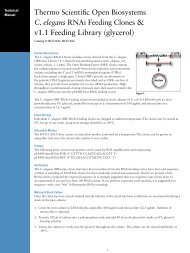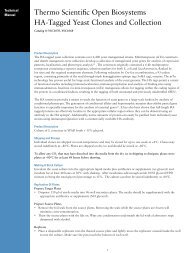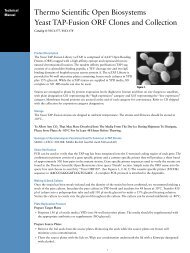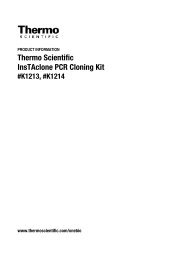Yeast Knockout Clones and Collections - Thermo Scientific
Yeast Knockout Clones and Collections - Thermo Scientific
Yeast Knockout Clones and Collections - Thermo Scientific
You also want an ePaper? Increase the reach of your titles
YUMPU automatically turns print PDFs into web optimized ePapers that Google loves.
Technical<br />
Manual<br />
<strong>Thermo</strong> <strong>Scientific</strong> Open Biosystems<br />
<strong>Yeast</strong> <strong>Knockout</strong> <strong>Clones</strong> <strong>and</strong> <strong>Collections</strong><br />
Catalog #:<br />
YSC1021 <strong>Yeast</strong>: <strong>Yeast</strong> Knock Out Strain YSC4300 <strong>Yeast</strong> Heterozygous (plates 281-282)<br />
YSC1053 <strong>Yeast</strong> MATa Collection YSC4343 <strong>Yeast</strong> Heterozygous Plate 282<br />
YSC4298 <strong>Yeast</strong> MATa (plates 72-73) YSC4508 <strong>Yeast</strong> Heterozygous (plates 283-284)<br />
YSC4341 <strong>Yeast</strong> MATa (plate 73) YSC4619 <strong>Yeast</strong> Heterozygous (plates 285-286)<br />
YSC4506 <strong>Yeast</strong> MATa (plates 74-75) YSC1056 <strong>Yeast</strong> Homozygous Diploid Collection<br />
YSC1054 <strong>Yeast</strong> MATalpha Collection YSC4301 <strong>Yeast</strong> Homozygous (plates 69-70)<br />
YSC4299 <strong>Yeast</strong> MATalpha (plates 172-173) YSC4344 <strong>Yeast</strong> Homozygous Plate 70<br />
YSC4507 <strong>Yeast</strong> MATalpha (plates 174-175) YSC4509 <strong>Yeast</strong> Homozygous (plates 71-72)<br />
YSC1055 <strong>Yeast</strong> Heterozygous Collection YSC1057 <strong>Yeast</strong> Essential Collection<br />
Product Description<br />
A nearly complete set of yeast open reading<br />
frame (ORF) knock-outs has been produced<br />
by the Saccharomyces Genome Deletion<br />
Project (SGDP).1 A PCR based strategy was<br />
used to replace each ORF with a KanMX<br />
cassette containing unique tags or barcodes<br />
for each deletion. Four different mutant<br />
Figure 1. An Excel file denoting the plate locations of each particular knock-out<br />
collections have been generated: haploids strain in the collection can be found online at http://www.openbiosystems.com/YKO<br />
of mating types MATa <strong>and</strong> MATalpha,<br />
homozygous diploids for non-essential genes,<br />
<strong>and</strong> heterozygous diploids, which contain the essential <strong>and</strong> non essential ORFs.<br />
Shipping <strong>and</strong> Storage<br />
Individual clones are shipped at room temperature <strong>and</strong> may be stored for up to one week at +4°C. They may be<br />
stored indefinitely at -80°C. Plates are shipped on dry ice <strong>and</strong> should be stored at -80°C.To allow any CO 2 that<br />
may have dissolved into the media from the dry ice in shipping to dissipate, please store plates at -80°C for at least<br />
48 hours before thawing.<br />
Obtaining Clone Information<br />
Clone details such as vector information, antibiotic resistance <strong>and</strong> sequence of insert are available online from the<br />
website below. The results will be organized into tabs based on the product category.<br />
https://www.openbiosystems.com/<br />
Click on the vector name from the gene search result for vector information. This will open a separate window<br />
containing vector properties including antibiotic resistance, vector map <strong>and</strong> sequence files.<br />
Click on the clone ID to open the cloning details section.<br />
Click on the accession associated with the clone to view insert information. This is the NCBI reference for the<br />
clone-it is the sequence of the insert for the clone.<br />
Glycerol Stock Replication<br />
Culture S. cerevisiae in YPD broth + G418 (200 μg/mL). Add 15% glycerol prior to freezing.<br />
Replication of Individual <strong>Clones</strong><br />
Inoculate the yeast culture into the appropriate liquid media plus antibiotics or supplements (no glycerol) <strong>and</strong><br />
incubate for at least 48 hours at 30°C with shaking. After incubation add enough sterile 50/50 glycerol/YPD<br />
mixture to bring the total glycerol percentage to 15%. The culture can then be stored indefinitely at -80°C<br />
Replication of 96-well Plates<br />
• Place a disposable replicator into the thawed source plate <strong>and</strong> lightly move the replicator around inside the well<br />
to mix the culture. Make sure the pins touch the bottom of each well.<br />
• Gently remove the replicator from the source plate <strong>and</strong> place the replicator into the target plate. Carefully move<br />
the replicator back <strong>and</strong> forth in the target plate to transfer the cells.<br />
1
• Discard the replicator.<br />
• Place the lids back on the plates.<br />
• Repeat this process until all plates have been replicated.<br />
• Return the source plates to the -80ºC freezer.<br />
• Place the inoculated target plates in a 30ºC incubator. Incubate the plates for at least 48 hours.<br />
• Seal the source plates, being careful to avoid cross-contamination.<br />
<strong>Yeast</strong> Knock Out Protocols<br />
Deletion Strategy<br />
http://www-sequence.stanford.edu/group/yeast_deletion_project/PCR_strategy.html<br />
Strain Verification<br />
http://www-sequence.stanford.edu/group/yeast_deletion_project/verification.html<br />
Strain Confirmation<br />
http://www-sequence.stanford.edu/group/yeast_deletion_project/project_desc.html#delconfirm<br />
Kan Cassette Sequence<br />
http://www-sequence.stanford.edu/group/yeast_deletion_project/KanMX4.html<br />
kanB <strong>and</strong> kanC Primers<br />
http://www-sequence.stanford.edu/group/yeast_deletion_project/kanB_kanC_seq.html<br />
KO Specific Primers<br />
http://www-sequence.stanford.edu/group/yeast_deletion_project/downloads.html<br />
References<br />
Winzeler, E.A., et al., Functional characterization of the Saccharomyces cerevisiae genome by gene deletion <strong>and</strong><br />
parallel analysis, Science, 285:901-906, 1999.<br />
Giaever, G., et al., Functional profiling of the Saccharomyces cerevisiae genome, Nature 418: 387-391 (2002)<br />
Wach, A., Brachat, A., Poehlmann, R. & Philippsen, P. (1994). New heterologous modules for classical or PCRbased<br />
gene disruptions in Saccharomyces cerevisiae, <strong>Yeast</strong> 10, 1793-1808.<br />
<strong>Yeast</strong> <strong>Knockout</strong> Useful Information<br />
Genotypes<br />
http://www-sequence.stanford.edu/group/yeast_deletion_project/faqs.html#strainbkgrds<br />
For an explanation of deletion strain confirmation:<br />
http://www-sequence.stanford.edu/group/yeast_deletion_project/project_desc.html#delconfirm<br />
Strain Verification<br />
For each ORF, two independent deletion mutants must be produced. This can be done in either of three ways:<br />
1. Transformation of haploids. The diploids are then obtained by mating.<br />
2. Transformation of diploids. The haploids <strong>and</strong> homozygous diploids are obtained by sporulation <strong>and</strong> mating<br />
3. Transformation of one of the haploid strains <strong>and</strong> the diploid strain. The other haploid strain is obtained from<br />
the diploid by sporulation <strong>and</strong> the homozygous diploid is made by mating of the two haploids. The genotypes<br />
of the a <strong>and</strong> alpha segregants have to match those of BY4741 <strong>and</strong> BY4742, respectively.<br />
Haploid Transformants<br />
A-KanB <strong>and</strong> KanC-D tests must be positive with the deletion mutant <strong>and</strong> negative with wild-type. If one of these<br />
reactions doesn't work, the A-D* test can substitute.<br />
A-B <strong>and</strong> C-D tests: Both must be negative with the deletion strain <strong>and</strong> positive with wild-type.<br />
Heterozygotes<br />
A-B, C-D, A-KanB <strong>and</strong> KanC-D PCR products must be present. An A-D* test can substitute if either the A-KanB or<br />
KanC-D PCR doesn't work.* Because the sizes of the A-D b<strong>and</strong>s can be similar in wild-type <strong>and</strong> mutant strains, it<br />
can be helpful to digest part of the A-D reaction with HindIII to test for the HindIII site in the KanMX4 cassette<br />
2
Haploid Segregants<br />
A-B <strong>and</strong> C-D products must be present in wild-type but not in the mutant. For at least one deletion-specific primer<br />
pair, either an A-KanB, KanC-D, or an A-D b<strong>and</strong> of the expected size must be present.<br />
Homozygous Diploids<br />
Must be met+lys+, streaked to single colonies, <strong>and</strong> tested for both mating <strong>and</strong> sporulation.<br />
Link To List Of Deletion Primers On SGDP<br />
http://www-sequence.stanford.edu/group/yeast_deletion_project/Deletion_primers_PCR_sizes.txt<br />
FAQS/Troubleshooting<br />
For answers to questions that are not addressed here, please email technical support at<br />
openbiosystems@thermofisher.com with your question, your sales order or purchase order number <strong>and</strong> the catalog<br />
number or clone ID of the construct or collection with which you are having trouble.<br />
Alternatively, you can search our online FAQ database: https://www.openbiosystems.com/Help/FAQ/<br />
3<br />
Contact Information<br />
Technical Support<br />
Tel: 1.888.412.2225<br />
Fax: 1.256.704.4849<br />
openbiosystems@<br />
thermofisher.com<br />
© 2010 <strong>Thermo</strong> Fisher<br />
<strong>Scientific</strong> Inc. All rights<br />
reserved. Trademarks<br />
are the property of their<br />
respective owners. All<br />
other trademarks are<br />
the property of <strong>Thermo</strong><br />
Fisher <strong>Scientific</strong> Inc.<br />
<strong>and</strong> its subsidiaries. For<br />
Research Use Only.


